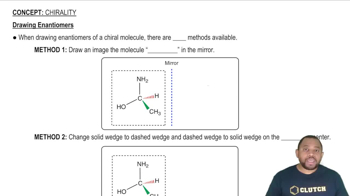Tell how many diastereoisomers are possible for each of the following complexes, and draw their structures.
(c) [Cu(H2O)4Cl2]+
(d) Ru(NH3)3I3
 Verified step by step guidance
Verified step by step guidance


Tell how many diastereoisomers are possible for each of the following complexes, and draw their structures.
(c) [Cu(H2O)4Cl2]+
(d) Ru(NH3)3I3
Which of the following complexes can exist as enantiomers? Draw their structures.
(a) [Cr(en)3]3+
(b) cis-[Co(NH3)Cl]2+
(c) trans-[Co(en)2(NH3)Cl]2+
(d) [Pt(NH3)3Cl3]+
What is the crystal field energy level diagram for the complex [Fe(NH3)6]3+?
(a)
(b)
(c)
(d)
Draw the three possible diastereoisomers of the triethylenetetramine complex [Co(trend)Cl2]+. Abbreviate the flexible tetradentate trien ligand H2NCH2CH2NHCH2CH2NHCH2CH2NH2 as . Which of the isomers can exist as a pair of enantiomers?
What is a racemic mixture? Does it affect plane-polarized light? Explain.
Draw the structure of all isomers of the octahedral complex [NbX2Cl4]- (X- = NCS-), and identify those that are linkage isomers.